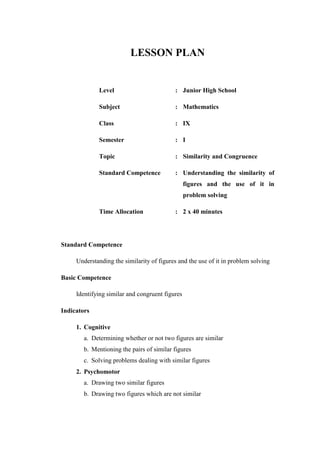
JHS Math Lesson on Similarity & Congruence
- 1. LESSON PLAN Level : Junior High School Subject : Mathematics Class : IX Semester : I Topic : Similarity and Congruence Standard Competence : Understanding the similarity of figures and the use of it in problem solving Time Allocation : 2 x 40 minutes Standard Competence Understanding the similarity of figures and the use of it in problem solving Basic Competence Identifying similar and congruent figures Indicators 1. Cognitive a. Determining whether or not two figures are similar b. Mentioning the pairs of similar figures c. Solving problems dealing with similar figures 2. Psychomotor a. Drawing two similar figures b. Drawing two figures which are not similar
- 2. 3. Affective a. Characterized Behaviors Responsibility, willingness to help others, and the feel of never surrender. b. Social Skills Team working, be active in discussion, be brave to deliver ideas, be open to criticisms, and be able to give others the opportunity to speak up. Learning Objectives 1. Cognitive a. Given two figures, students are supposed to be able to determine whether or not the figures are similar b. Given some problems dealing with the concept of similarity, students are supposed to be able to solve them. 2. Psychomotor a. After learning about similar figures, students are supposed to be able to draw a pair of similar figures. b. After learning about similar figure, students are supposed to be able to draw a pair of figures which are not similar. 3. Affective a. Characterized Behaviors Being involved in a student-centered learning activities, students are supposed to be able to show responsibility, wilingness to help others, and the feel of never surrender at least be judged as “Starts to appear”. b. Social Skills Being involved in a student-centered learning activities, students are supposed to be able to work in teams, be active in discussion, be open
- 3. to criticisms, and be able to give others the opportunity to speak up at least be judged as “In Progress”. Learning Model Learning Model : Problem-Based Instruction Learning Activities Introduction (± 10 minutes) 1. Phase 1.Students on the issue orientation o Teacher leads the students to recall what they have learned from the previous meeting. These questions may help: “What did you learn in the last meeting? Is it about similarity? What are the properties of two similar figures? When are two figures said to be similar?” o Motivation: Teacher gives an illustration of an event taken from daily life related to the concept of similarity. Here is one of the possible illustrations. All of you must have allowance or pocket money. Your parents most likely give you the money at the beginning of the week. Now, take a look at the money that you have in your pocket right now! Do you have any coins with you? Last meeting we had studied about similarity and the properties of two similar figures. Now, what do you think about the coins? Are they similar? Why are they or why are not they? And now, do you have cash? In what shape are they? Are they similar? Why are they or why are not they? o Teacher communicates the outlines of basic competence and indicator that will be learnt.
- 4. o Teacher leads students to recall the lesson that had been learnt in the previous meeting e.g. “when are two figures said to be similar? What are the requirements for two figures to be congruent?”. o Teacher may „gradually‟ lead students to deal with the topic which is going to be delivered in the meeting. Main Activities (± 70 minutes) 2. Phase 2.Organize students to learn o In this stage, teacher can divide students into several learning groups containing three to four students. o Further, teacher can pose a problem dealing with similarity (the problems are available in the worksheet). 3. Phase 3.Guide theinvestigationof individualand group o Teacher guides and assists students to work in groups to solve the problems. 4. Phase 4.Develop and present the work o Teacher helps students to present the work (the result of the discussion) in front of the class. 5. Phase 5.Analyze and evaluate the problem solving process o In this phase, teacher may ask several groups to present their work. o Teacher emphasizes that the other student who do not get the chance to present their work shoul give their opinion regarding to the presenting teams‟ works. Here, teacher leads the discussion and helps students to settle the problem by getting closer to the right answer. Note: Teacher can also modify the learning activities by posing more than one problem. In modifying this, teacher may provide more than one worksheet. Then, the learning activities will be going back to the second step until the fifth step. This can be repeated until all the problems have been settled. Here, I suggest to use two or three problems in two or three worksheets. Closure (± 10 minutes) o Teacher leads students to conclude what they have learned that day.
- 5. o Teacher might ask the students to write a reflection regarding to the lesson and the learning activities that they have experienced that day. o Teacher may also gives homework for students to practice. o Teacher closes the lesson that day. Assessment The assessment can be done by assessing the student performance during the project presentation, the content of the work presented, and also the activities within the groups. The students who do not present their work are assessed by the worksheet/s that have/s been completed.
